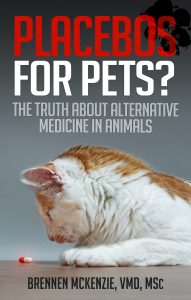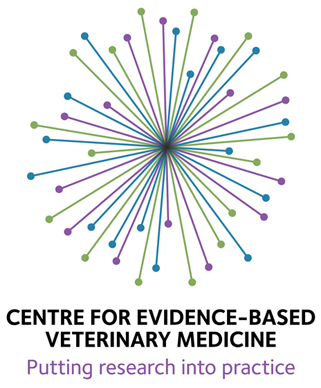From the Science-Based Medicine Blog: Complementary and Alternative Medicine in Hospice Care
A number of news outlets (e.g. Bloomberg Business Week, MSN.Com, US News, etc) have recently reported that use of complementary and alternative therapies (CAT) is widespread in hospice care facilities. This is based on a report from the Centers for Disease Control, Complementary and Alternative Therapies in Hospice: The National Home and Hospice Care Survey, Untied States, 2007. According to most news reports, about 42% of hospice care providers offer some kind of CAT.
I was initially inclined to find this a little worrisome. In my own field of veterinary medicine, advocates of alternative therapies are prominent among the organizers of the nascent hospice care movement. And while I am strongly supportive of better and more available veterinary hospice care, the involvement of CAM advocates raises the concern that animals at the end of their life might receive ineffective palliative care, or be denied the benefits of conventional treatments by some CAM providers, who often characterize “allopathic” treatments as “unnatural” and harmful.
In practice, I have seen this happen to patients with terminal diseases. I will never forget a Rottweiler dog I diagnosed with osteosarcoma, a very painful bone cancer, whose owner was convinced that homeopathy was adequate to control his pain and refused to use NSAIDs because of her conviction they were “toxic.” I have also seen my patients denied euthanasia even in the face of great suffering because so-called “animal communicators” claimed the pet was “not ready to leave” and had expressed a desire to remain with their owner as long as possible.
Perhaps these experiences have made me overly sensitive on this subject, but I saw these recent news reports and pictured people at the end of their lives being similarly denied effective palliative care or subjected to pointless therapies like homeopathy and “energy medicine,” or even more worrisome treatments like chiropractic or herbal remedies with real risks. However, a little digging into the details suggests that the headlines are a bit misleading, and these fears are probably unfounded.
As always, when trying to assess how popular alternative medical therapies are, the tricky issue arises of defining “alternative.” In this study, the authors referenced the MedlinePlus definition:
Complementary and alternative medicine (CAM) is the term for medical products and practices that are not part of standard care. Standard care is what medical doctors, doctors of osteopathy and allied health professionals, such as registered nurses and physical therapists, practice. Alternative medicine means treatments that you use instead of standard ones. Complementary medicine means nonstandard treatments that you use along with standard ones. Examples of CAM therapies are acupuncture, chiropractic and herbal medicines.
Personally, I prefer Dr. Novella’s definition:
CAM is a political/ideological entity, not a scientific one. It is an artificial category created for the purpose of promoting a diverse set of dubious, untested, or fraudulent health practices. It is an excellent example of the (successful) use of language as a propaganda tool.
In any case, in order to measure the popularity of something, one has to define it in some way, and in the past assessments of how popular or widespread CAM use is have created misleading impressions due to dodgy definitions. For example, the 2007 National Health Interview Survey (discussed in detail here) reported 30% of Americans to be regular CAM users. A closer look at the details of the survey, however, showed that very little of this self-reported usage involved the application of the usual dubious CAM approaches (e.g. acupuncture, chiropractic, homeopathy, various herbal traditions, etc) to treat specific medical problems. Much of this supposed CAM usage involved the non-medical application of massage, yoga, tai chi, prayer, and so on to provide psychological comfort or facilitate relaxation.
Of course, if one argues that massage, yoga, or even prayer are effective in reducing the objective signs or disease, or even bringing about a cure, then one could argue these are forms of alternative medicine. But such methods are mostly employed to provide comfort and help patients cope with their illness, and as such they can be valuable and legitimate interventions. This does not make them medical therapies, however, alternative or otherwise.
The hospice care survey suffers from the same kind of problematic definition for “complementary and alternative.” According to the report’s technical notes, providers of hospice care were asked first to choose all the services they offered from a list, and “Complementary and Alternative Medicine (CAM)” was one of the choices. Those that indicated they offered CAM were then asked to indicate “Which of these complementary and alternative medicine therapies does this agency use?”
Here is the list:
- Acupuncture
- Aromatherapy
- Art therapy
- Guided imagery or relaxation
- Massage
- Music therapy
- Pet therapy
- Supportive group therapy
- Therapeutic touch (a westernized version of reiki)
- TENS (Transcutaneous Electrical Nerve Stimulation)
- Other
Personally, I see little on this list that I would classify as CAM. Acupuncture, certainly, along with therapeutic touch (like reiki) and aromatherapy. But most of the rest, unless specifically marketed as treatments for disease, seem more like benign, pleasurable activities designed to provide comfort, relaxation, and enjoyable stimulation. As a veterinarian, I work with a lot of pet therapy dogs, and I have yet to run across a handler of one who thought they were practicing alternative medicine! (Though I suppose there might be some such folks out there). And TENS is a perfectly conventional intervention, often somewhat disingenuously confused with acupuncture.
The most popular of the “true” CAM therapies offered was therapeutic touch, available at 48.3% of facilities. Aromatherapy was offered by 39.7% of hospice providers. I cannot even find a number for acupuncture in the report. And by far the most popular “alternative” therapies offered were massage (71.7%), group therapy (69%), music therapy (62.2%), and pet therapy (58.6%).
The report also indicates that only 8.6% of patients discharged from a hospice facility that offered CATs actually received one of these therapies. So even under such a loose definition of alternative, there is no evidence that large numbers of hospice patients are receiving alternative medical treatments.
It wouldn’t surprise me if we begin to see advocates of alternative medicine proclaiming that this report shows CAM is widely available, popular, and even indispensible in hospice care. The 2007 National Health Interview Survey results were frequently used this way to create the impression that CAM is becoming mainstream and that resistance to it is the province of extremists and ultimately futile. The details of both surveys, however, indicate that even with aggressive expansion of the definition of CAM to include conventional therapies such as TENS and non-medical interventions like pet therapy, CAM is not truly as popular ubiquitous as its proponents claim.
There is little objectionable from a science-based medicine perspective in most of the therapies hospice care providers are offering, according to this study. I enjoy a good massage, relaxing music, and the company of a friendly dog as much as anyone. And those elements that are truly nonsense, such as therapeutic touch and aromatherapy, are unlikely to do harm or replace appropriate conventional therapies, and they seem in any case not to be especially popular with patients even when they are available. So regardless of what PR use is made of this study, it does not suggest that human hospice care is becoming predominantly the domain of CAM providers, as I might have feared. I only hope the same will be true of veterinary hospice care as that becomes, hopefully, more commonplace.









